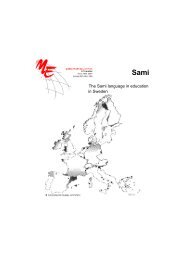Multilingual Early Language Transmission (MELT) - Mercator ...
Multilingual Early Language Transmission (MELT) - Mercator ...
Multilingual Early Language Transmission (MELT) - Mercator ...
Create successful ePaper yourself
Turn your PDF publications into a flip-book with our unique Google optimized e-Paper software.
children was not good for their intellectual development. In the 1970s, on the basis of new<br />
research results, linguists concluded, that there is no single language or several languages as<br />
such in the cognitive system of the child. Instead of there is common underlying proficiency<br />
for the language acquisition and development. Depending on the language or the languages<br />
which are spoken to the child, the child will acquire and learn one, two, three or more<br />
languages, either parallel and at the same time or the one after the other, sequentially.<br />
(illustration 3.2) (Cummins, 2001).<br />
Cummins (1979) developed the "Iceberg" model, the theory of language interdependence.<br />
Instead of having two separate areas for two languages in the cognitive system, this model<br />
posits that the common features of languages are stored together and common knowledge<br />
is linked and can interact. This model shows that the two languages are kept separate only at<br />
the surface level, where they are used for listening, speaking, reading and writing.<br />
Figure 3.4 Iceberg Model of <strong>Language</strong> Interdependence of languages (Cummins, 1979, 1981)<br />
From 1970s onwards a number of research studies were published on BFLA quality and it<br />
was not always clear whether children were growing up in a BFLA environment or not (De<br />
Houwer, 2009). Volterra & Taeschner(1978) are opposed to the theory of Leopold. They<br />
argue that young bilingual children prefer the mixed language to speaking one of the<br />
languages separately; a position which is no longer upheld according to De Houwer (2009).<br />
However, Grosjean (2010) questions what is meant by “mixing.” Does it refer to<br />
interferences in language-dominant children or to code-switching and borrowings? These<br />
questions are currently (2011) a subject of research.<br />
Some case studies were published in the 1980s. George Saunders (1983) wrote a book on his<br />
bilingual family: he raised his children in German, English, and Australian English. He spoke<br />
German with his children, and his wife spoke Australian English; they were living in<br />
Australian. Saunders described how a bilingual family is not an island, but part of a larger<br />
community, even if that community is monolingual. More recently, Stephen Caldas (2006)<br />
59



